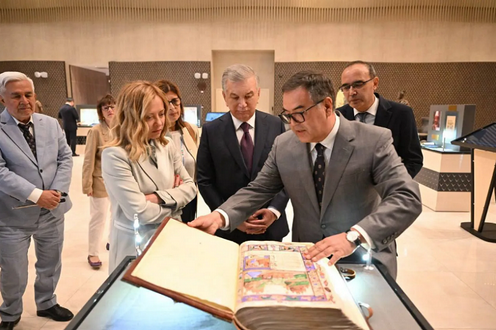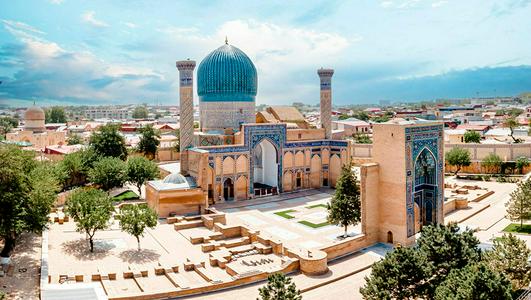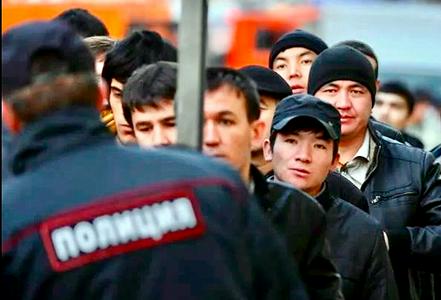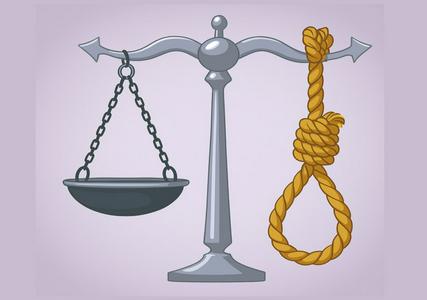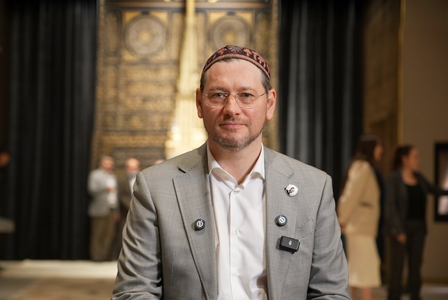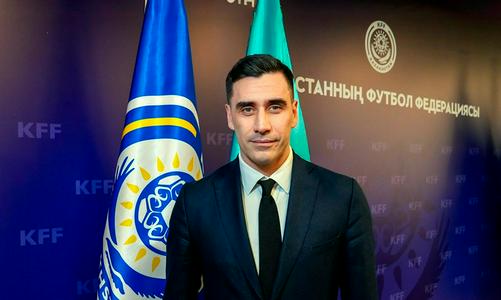Uzbekistan’s President Shavkat Mirziyoyev and Italian Prime Minister Giorgia Meloni visited the exhibition “Uzbekistan and Italy: Dialogue of Civilizations”, held at the Samarkand Congress Center, according to a statement from the Uzbek president’s press service.
The exhibition opened with a remarkable Florentine mosaic reproduction of the Afrasiab fresco “Reception of Ambassadors by the Ruler of Samarkand”, created by renowned Italian artist Mauro Pellizzoni. The two leaders were also introduced to a wide array of artifacts, digital projections, manuscripts and miniatures, rare literary works, sculptures, archival photographs, and documents.
Firdaus Abdukhaliqov, head of the Center of Islamic Civilization and chair of the World Society for the Study, Preservation and Promotion of Uzbekistan’s Cultural Heritage (WOSCU), guided the tour.
The exhibition explores the historical, scientific, and cultural ties between the two countries and is divided into nine thematic sections: “Trade Relations Between the Roman and Kushan Empires,” “The First Renaissance,” “Marco Polo,” “Amir Temur,” “Mirzo Ulugbek,” “Mirzo Babur,” “Italians in Uzbekistan in the 19th Century,” “The Contribution of Uzbeks to the Liberation of Italy During World War II,” and “Uzbekistan and Italy: Preserving Cultural Heritage.”
ℹ️ Uzbekistan and Italy maintain close cultural cooperation. Last year, Tashkent hosted the media event “Cultural Heritage as a Bridge Between Italy and Uzbekistan,” which featured the presentation of the new book-album “Uzbekistan’s Cultural Heritage in Italian Collections”—part of WOSCU’s ongoing “Uzbekistan’s Cultural Heritage in the World’s Collections” project. The Italian ambassador to Uzbekistan, Agostino Pinna, noted at the time that high-level collaboration between the two countries continues to deepen through frequent exchanges between their heads of state.
“These visits open new chapters in the bilateral partnership. They mark important steps forward in cultural, historical, economic, and political relations. Uzbekistan has a rich cultural legacy, and we’ve always been fascinated by the many Uzbek artifacts preserved in Italy,” Pinna stated.
Akmal Saidov, First Deputy Speaker of the Legislative Chamber of Uzbekistan’s parliament and chair of the editorial board of the “Uzbekistan’s Cultural Heritage in the World’s Collections” project, emphasized the importance of cultural and humanitarian ties between the Central Asian nation and the European country.
“Italy was the cradle of the European Renaissance, while Uzbekistan—historically known as Mawarannahr—was home to the first and second stages of the Eastern Renaissance. The great philosopher Hegel once said, ‘The Renaissance begins in the East.’ [...] The books published by the World Society can be seen as unique academic contributions that bring the legacy of the Eastern Renaissance to contemporary readers. More than 20 scholars passionate about Uzbekistan’s cultural heritage contributed to the new book-album ‘Uzbekistan’s Cultural Heritage in Italian Collections’,” Saidov remarked.
In the fall of last year, Mauro Mantovani, Prefect of the Vatican Apostolic Library, expressed interest in strengthening ties with WOSCU and proposed involving the society’s scholars in the study of the library’s archives. During a meeting with WOSCU member and president of the Italian publishing house Sandro Teti Editore, Sandro Teti, Mantovani received a copy of the book “Kamoliddin Behzad: The Artist Who Shamed Mani” and discussed potential collaboration, including consultation on ancient manuscripts housed in the library’s restricted collection.
In February, it was announced that rare artifacts from Italian museums and private collections would be displayed at the Center of Islamic Civilization (CIC) in Tashkent, coinciding with the Center’s official opening. The exhibition was made possible following a successful visit to Italy by a CIC delegation led by Firdaus Abdukhaliqov.
“We are deeply grateful to our colleagues and friends in Italy for their decision to take part in this important event. Until now, we have published information about Uzbekistan’s cultural heritage in the format of illustrated books and albums, but now, thanks to the initiative of our esteemed President Shavkat Mirziyoyev and the support of our international partners, we can view these cultural treasures in person at the Center of Islamic Civilization. I am confident that the Italian section of the exhibition will draw the attention of all those who cherish our country’s heritage,” Abdukhaliqov stated.
